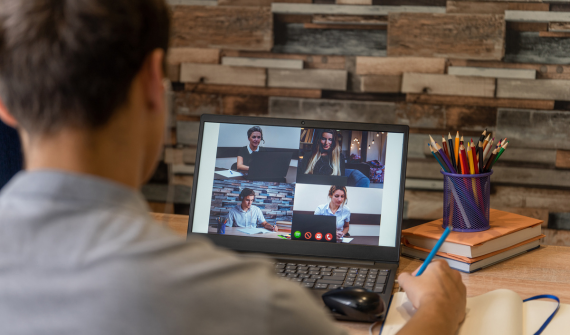What is Video-based Learning and What are its Benefits?
In the digital age, video-based learning has emerged as a powerful and popular approach to education and training.
Studies show that individuals retain and perceive 90% of information received through video content compared to text, as highlighted by Forbes.
This innovative method harnesses the engaging and immersive nature of videos to deliver educational content, foster understanding, and enhance learning outcomes.
In this article, we delve into the concept of this type of learning, examining its definition, features, and the wide range of benefits it offers.
From increased retention and comprehension to flexibility and accessibility, video learning has the potential to revolutionize traditional learning practices.
By understanding the benefits of video-based learning, readers will gain insights into its potential applications and how it can be integrated into their own educational or training initiatives.
Join us as we uncover the power of learning and explore how it can transform the way we acquire knowledge and skills in today's dynamic world.
What Is Video-Based Learning Theory?

Video-based learning theory is a framework that explains how videos can effectively facilitate learning and knowledge acquisition.
It draws upon principles from educational psychology, multimedia learning, and cognitive science to explore the unique characteristics and potential of video as an educational tool.
This theory posits that videos offer a multisensory learning experience by combining visual, auditory, and sometimes kinesthetic elements, resulting in enhanced engagement and information processing.
The dynamic and interactive nature of videos stimulates cognitive processes, such as attention, perception, and memory, which contribute to effective learning outcomes.
By leveraging various instructional strategies, such as storytelling, demonstrations, and simulations, video-based learning theory promotes active learning, problem-solving, and critical thinking.
It emphasizes the importance of designing videos with clear learning objectives, proper sequencing of the information, and appropriate scaffolding to optimize knowledge retention and transfer.
Understanding video-based learning theory allows educators and instructional designers to create compelling and impactful video learning experiences.
By aligning instructional techniques with the theory's principles, they can harness the full potential of videos to engage learners, facilitate comprehension, and promote meaningful learning experiences.
Types Of Video Based Learning
It encompasses a diverse range of formats that cater to different learning objectives and preferences.
Here are some prominent types of video-based learning
1. Instructional Videos
These videos focus on delivering step-by-step instructions or demonstrations to teach specific skills or processes.
They are often used in technical or vocational training, where learners can visually observe and learn practical tasks.
2. Educational Lectures
In this format, videos replicate traditional classroom lectures, allowing learners to access educational content remotely.
Lectures can be delivered by subject matter experts or renowned educators, providing in-depth explanations and insights on various topics.
3. Explainer Videos
These short, concise videos use animation, graphics, or visuals to simplify complex concepts and make them more easily understandable.
Explainer videos are particularly effective for presenting abstract or difficult-to-grasp subjects.
4. Case Studies And Simulations
Video-based case studies and simulations simulate real-world scenarios, allowing learners to observe and analyze practical applications of knowledge.
They promote critical thinking, decision-making, and problem-solving skills.
5. Webinars And Virtual Presentations
These live or recorded video sessions enable interactive learning experiences, where participants can engage with presenters, ask questions, and participate in discussions. These video sessions have also introduced a number of etiquettes that participants follow.
Webinars are widely used for professional development and knowledge sharing.
6. Interview-Style Videos
Interviews featuring subject matter experts, industry leaders, or professionals offer insights, expertise, and personal experiences.
These videos provide valuable perspectives and stimulate discussions.
7. Video-Based Assessments
Videos can be integrated into assessments, where learners analyze or respond to questions based on video content.
This format allows for practical application and evaluation of knowledge and skills.
Each type of learning has its own strengths and suitability for different learning contexts.
By selecting the appropriate format, educators and instructional designers can create engaging and effective learning experiences that align with their learning objectives and target audience preferences.
Video Based Learning Benefits

The Training Industry Report of 2021 reveals that a significant 88% of organizations utilize video broadcasting, webcasting, or virtual classrooms as part of their employee training programs.
It offers a multitude of benefits that enhance the learning experience and promote better educational outcomes.
Here are some key video based learning benefits:
1. Enhanced Engagement
Videos captivate learners' attention through dynamic visuals, storytelling, and multimedia elements, fostering greater engagement and participation in the learning process.
2. Visual And Auditory Learning
Videos combine visual and auditory stimuli, catering to diverse learning styles and maximizing information retention.
Learners can see concepts visually demonstrated and hear explanations simultaneously, reinforcing comprehension.
3. Improved Comprehension And Retention
The combination of audiovisual elements in videos aids in information processing and memory retention.
Visual cues, animations, and demonstrations help learners understand complex concepts and remember information more effectively.
4. Flexibility And Accessibility
Videos can be accessed anytime, anywhere, allowing for flexible learning.
Learners can revisit video content, pause, rewind, or watch at their own pace, accommodating different schedules and learning preferences.
5. Multisensory Learning Experience
Videos stimulate multiple senses, creating a multisensory learning experience that enhances knowledge acquisition and retention.
This immersive approach promotes deeper understanding and long-term retention of information.
6. Engaging And Varied Content
This type of learning enables the use of diverse content formats, such as animations, interviews, simulations, and real-life examples.
This variety keeps learners interested, motivates active learning, and enhances knowledge transfer.
7. Global Reach And Collaboration
Videos facilitate remote learning and enable collaboration among learners across different geographical locations.
Learners can benefit from global perspectives, expertise, and diverse cultural insights through video-based interactions.
8. Scalability And Cost-Effectiveness
Once created, videos can be easily replicated and distributed to a large audience, making them a cost-effective solution for scalable education and training initiatives.
This type of learning harnesses the power of visual storytelling and multimedia to create engaging and impactful learning experiences.
By leveraging these benefits, educators and learners can tap into the full potential of video-based learning to acquire knowledge, develop skills, and foster a deeper understanding of complex subjects.
Oreed: Unleash The Power Of Education Intelligence
Harness the transformative potential of Oreed's education intelligence platform to unlock unparalleled insights, optimize learning experiences, and empower your organization's growth.
- Unleash the power of personalized learning with Oreed, revolutionizing employee training.
- Gain a comprehensive understanding of your employees' unique training needs for a tailored learning experience.
- Design customized training and courses that align with your organization's specific requirements.
- Measure the impact and effectiveness of your training initiatives with Oreed's advanced assessment feature.
- Say goodbye to generic, one-size-fits-all programs and embrace a personalized approach to workplace learning.
- Elevate your organization's learning culture and unlock the true potential of your workforce with Oreed.
So what are you waiting for? If you are planning to host an online event, book a demo with Oreed today and get a walk of all our features.
Promote lifelong learning through Oreed by experiencing the most powerful all-in-one training and development intelligent platform that streamlines all your organization's learning, training, and development activities in one place.
Final Thoughts
In conclusion, embracing immersive and engaging learning methods has become increasingly vital in the modern educational landscape.
By leveraging multimedia elements and interactive approaches, organizations can tap into the benefits of enhanced engagement, improved comprehension, and flexible accessibility.
The combination of visual and auditory stimuli, along with the flexibility to learn at one's own pace, creates a multisensory experience that promotes better retention of knowledge.
Furthermore, the scalability and cost-effectiveness of these approaches make them an attractive option for organizations seeking to reach a wider audience.
With the ability to deliver diverse and captivating content, these methods provide an opportunity to revolutionize traditional learning practices and unlock the full potential of learners.
By integrating these approaches into educational initiatives, we can foster a dynamic and effective learning environment that empowers individuals and promotes continuous growth.
FAQs
1. What are the various benefits of using video in e-learning?
Using videos in e-learning offers several benefits, including:
- Enhanced engagement: Videos capture learners' attention through visual and auditory stimuli, promoting active participation and engagement.
- Improved comprehension: Visual cues, animations, and demonstrations in videos help learners understand complex concepts and reinforce understanding.
- Retention of information: The combination of audio and visual elements in videos aids in memory retention, increasing the likelihood of information recall.
- Flexibility and accessibility: Videos can be accessed anytime and anywhere, allowing learners to learn at their own pace and accommodate different schedules.
- Multisensory learning experience: Videos stimulate multiple senses, facilitating a deeper understanding and better knowledge retention.
- Diverse content formats: Videos can present information in various formats such as animations, interviews, simulations, and case studies, catering to different learning preferences.
2. What is video learning?
Video learning refers to the use of videos as a central medium for delivering educational content and facilitating learning experiences.
It involves creating or curating video-based resources that cover specific topics, skills, or concepts.
Video learning can take various forms, including instructional videos, lectures, demonstrations, simulations, and interactive video modules.
It leverages the visual and auditory nature of videos to engage learners, promote comprehension, and enhance the overall learning experience.
4. What is the role of videos in the teaching-learning process?
Videos play a significant role in the teaching-learning process by:
- Facilitating visual and auditory learning: Videos combine visual and auditory elements to present information, catering to different learning styles and enhancing understanding.
- Enhancing engagement: Videos capture learners' attention and create a more dynamic learning environment, fostering active participation and motivation.
- Demonstrating concepts and procedures: Videos can effectively showcase real-life examples, demonstrations, and practical applications of concepts, making learning more tangible and relatable.
- Supporting self-paced learning: Videos can be accessed and reviewed at any time, allowing learners to control their own learning pace and revisit content as needed.
- Promoting active learning: Videos can be designed to include interactive elements, such as quizzes or reflection questions, encouraging learners to actively engage with the content.
- Providing access to diverse perspectives: Videos featuring experts, guest speakers, or diverse individuals can expose learners to different viewpoints, cultures, and experiences, promoting a broader understanding of the subject matter.
In summary, videos in the teaching-learning process serve as powerful tools to engage learners, present information effectively, and enhance the overall learning experience by providing a dynamic and immersive medium for educational content delivery.
